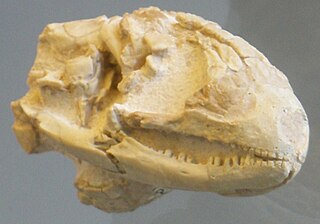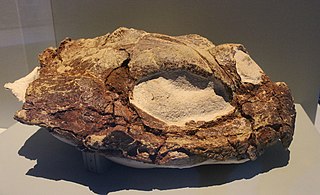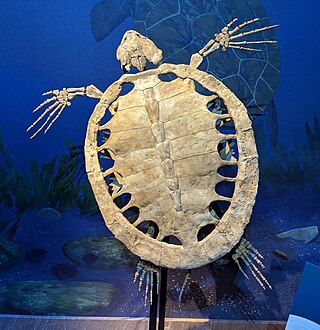
The Mustelidae are a diverse family of carnivoran mammals, including weasels, badgers, otters, polecats, martens, grisons, and wolverines. Otherwise known as mustelids, they form the largest family in the suborder Caniformia of the order Carnivora with about 66 to 70 species in nine subfamilies.

Pseudaelurus is a prehistoric cat that lived in Europe, Asia and North America in the Miocene between approximately twenty and eight million years ago. It is considered to be a paraphyletic grade ancestral to living felines and pantherines as well as the extinct machairodonts (saber-tooths), and is a successor to Proailurus. It originated from Eurasia and was the first cat to reach North America, when it entered the continent at about 18.5 Ma ending a 'cat-gap' of 7 million years. The slender proportions of the animal, together with its short, viverrid-like legs, suggest that it may have been an agile climber of trees.
Yurlunggur is a genus of fossil snake in the extinct family Madtsoiidae containing the species Yurlunggur camfieldensis known from the Oligocene and Miocene of Australia.
Paramachaerodus is an extinct genus of saber-tooth cat of the subfamily Machairodontinae, which was endemic to Eurasia during the Middle and Late Miocene from 15 to 9 Ma. A 2022 phylogenetic analysis suggested that the genus may be polyphyletic.

Ekorus ekakeran is a large, extinct mustelid mammal. Fossils, including largely complete skeletons, are known from the late Miocene of Kenya.

Peltosaurus is an extinct genus of anguid lizard from North America that lived from the Eocene to the Oligocene. Peltosaurus belongs to the anguid subfamily Glyptosaurinae. The type species Peltosaurus granulosus was named in 1873 by American paleontologist Edward Drinker Cope. Many additional species have been named, but most have been reassigned to different genera. For example, Peltosaurus piger, named in 1928, was reclassified as Odaxosaurus piger, and P. jepseni, named in 1942 from the Paleocene of Wyoming, but was later reclassified as Proxestops jepseni. In 1955 a new species, Peltosaurus macrodon, was named from the Eocene of California. Lizard bones from the Late Miocene of Nebraska were attributed to a new species of Peltosaurus called P. minimus in 1976, extending the fossil range of Peltosaurus and Glyptosaurinae into the Neogene. However, these bones were later referred to a genus of skinks called Eumeces, meaning that the fossil range of Peltosaurus and Glyptosaurinae does not go beyond the Paleogene.

Ancylotherium is an extinct genus of the family Chalicotheriidae, subfamily Schizotheriinae, endemic to Europe, Asia, and Africa during the Late Miocene-Early Pleistocene, existing for approximately 9.8 million years.
Potamotherium an extinct genus of caniform carnivoran from the Miocene epoch of France and Germany. It has historically been assigned to the family Mustelidae, but more recent studies suggest that it represents a primitive relative of pinnipeds

Tomarctus is a canid genus of the extinct subfamily Borophaginae which inhabited most of North America during the late Early Miocene to the Early Barstovian age of the Middle Miocene. Tomarctus existed for approximately 6.83 million years.

Psephophorus is an extinct genus of sea turtle that lived from the Oligocene to the Pliocene. Its remains have been found in Europe, Africa, North America, and New Zealand. It was first named by Hermann von Meyer in 1847, and contains seven species, P. polygonus, P. calvertensis, P. eocaenus, P. oregonesis, P. californiensis, P. rupeliensis, P. scaldii, and a species discovered in 1995, P. terrypratchetti.

Euclastes is an extinct genus of sea turtles that survived the Cretaceous–Paleogene mass extinction. The genus was first named by Edward Drinker Cope in 1867, and contains three species. E. hutchisoni, was named in 2003 but has since been reassigned to the genus Pacifichelys, while E. coahuilaensis named in 2009 was reassigned as Mexichelys coahuilaensis in 2010.

Rhynchotherium is an extinct genus of proboscidea endemic to North America and Central America during the Miocene through Pliocene from 13.650 to 3.6 Ma, living for approximately 10 million years.
The cat gap is a period in the fossil record of approximately 25 million to 18.5 million years ago in which there are few fossils of cats or cat-like species found in North America. The cause of the "cat gap" is disputed, but it may have been caused by changes in the climate, changes in the habitat and environmental ecosystem, the increasingly hypercarnivorous trend of the cats, volcanic activity, evolutionary changes in dental morphology of the Canidae species present in North America, or a periodicity of extinctions called van der Hammen cycles.

Megalictis is an extinct genus of large predatory mustelids that existed in North America during the "cat gap" from the Late Arikareean (Ar4) in the Miocene epoch. It is thought to have resembled a huge, jaguar-sized ferret, weighing up to 60–100 kilograms (130–220 lb).
Brachypsalis is an extinct genus of mustelids, which existed during the Miocene period.

Oligobuninae is an extinct subfamily of the family Mustelidae known from Miocene deposits in North America.
Zodiolestes is a genus of mustelids, now extinct, which existed during the Miocene period.
Promartes is a genus of mustelids, now extinct, which existed during the Miocene period.

The Thomas Farm site is an Early Miocene, Hemingfordian assemblage of vertebrate fossils located in Gilchrist County, northern Florida.

Lophocetus is an extinct genus of dolphin belonging to the clade Delphinida that is known from late Miocene (Tortonian) marine deposits in California and Maryland. Although usually placed in Kentriodontidae, recent studies have found it only distantly related to Kentriodon.



















